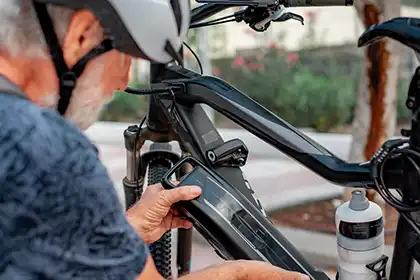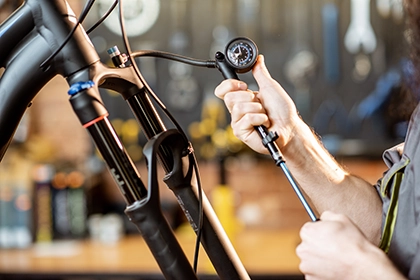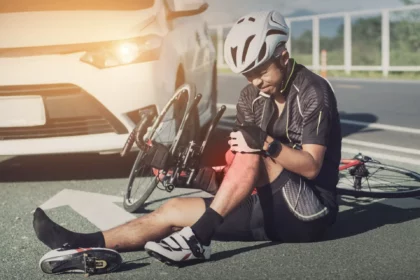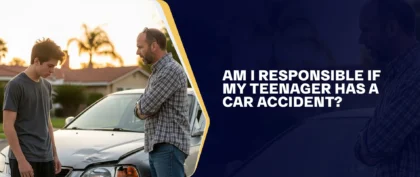Table of Contents
Electronic bikes (E-bikes) are a relatively new way to get around town. With their eco-friendly features and ability to help riders navigate through congested city streets, it’s no wonder they have become a favored mode of transportation for some people. If you are in a metropolitan area, you have likely seen locals zipping by on one, or maybe you’ve seen them stationed uniformly on a bike rack as you make your morning commute.
Compared to traditional bicycles and even cars, e-bikes offer convenience and cost-effectiveness. Commuters may appreciate that e-bikes can help them bypass traffic jams and arrive at their destinations more quickly. Perhaps the greatest feature that makes it all the more relevant is that e-bikes offer a sustainable solution, reducing carbon emissions and improving air quality.
Are you considering getting an electric bike, or do you already own one? While most of us take precautions to avoid accidents, they still happen beyond our control, and e-bikes do not exempt us from such unfortunate events. If you’ve been injured in an electric bike accident, seeking legal counsel can help you pursue fair compensation for your injuries and losses. Experienced bike accident attorneys can help you navigate the legal process. Nevertheless, discussions about the associated risks raise the question: “How safe are e-bikes?“
What Is An E-Bike?
E-bikes, or electric bicycles, are regular bikes with built-in electric motors that give you a boost when you pedal. These motors are powered by rechargeable batteries mounted on the bike. Unlike e-scooters, e-bikes require you to pedal to get motor assistance. The harder you pedal and the higher your support level, the more power the motor provides.
Electric bicycles can reach speeds of 60 mph. This vehicle enables riders to travel faster with less effort pedaling than traditional bicycles. However, like motorcycles, electric bikes pose similar safety concerns for riders. These bikes can also be involved in traffic collisions. When this happens, motor vehicle accident attorneys can provide assistance to victims, especially in pursuing compensation.
How Safe Are E-Bikes?
Depending on the model, some E-bikes are made of water-resistant parts that allow you to operate them even when it’s raining. You also won’t be stranded on the road if the battery gets discharged, as e-bikes can still be pedaled like regular bicycles. The only difference is that they won’t be able to provide assistance and may feel heavier.
However, like all other vehicles, e-bikes come with their own risks. For one, electric vehicles are more prone to overheating and catching fire because of their batteries, which may lead to burn injuries. This means you can’t just leave them in your garage or under the sun, especially during the summer when temperatures can quickly rise. In such cases, victims may have to consult fire-related injury attorneys to pursue compensation if someone else is liable for the incident. It could be the e-bike or battery manufacturer, depending on the facts of the case.
Electric bicycles also require specific skills. Just because you know how to ride a traditional bicycle doesn’t mean you can safely operate an e-bike without proper training.
According to federal safety data, e-bike-related emergency room visits have increased dramatically, with nearly half of all reported injuries between 2017 and 2022 alone. The alarming rate of traffic incidents has led some legislators to consider enacting stricter requirements on the use of electric bicycles. They are also proposing an age restriction since hundreds of kids get injured in bike accidents every day. Our traffic accident lawyers also advocate for safer streets and pursue accountability for those who put others at risk.
The Benefits Of Electric Bikes
Electric bikes, or e-bikes, are becoming increasingly popular, especially among city dwellers, as an alternative to traditional vehicles like cars, trucks, and buses. They offer numerous advantages over other forms of transportation, including:
- Increased Speed & Range — E-bikes help you travel farther and faster than regular bikes, making them suitable for commuting and exploring. They can travel long distances and even keep up with traffic flow.
- Improved Fitness — While pedaling is assisted, e-bikes still provide a good workout, boosting calorie burn. You can choose a bike that suits your fitness goals and enhance your exercise with fitness trackers and accessories.
- Effortless Riding — Riders of all ages and abilities can operate e-bikes. The pedal assist feature removes the strain of uphill climbs and long journeys.
- Cost-Effectiveness — E-bikes offer higher fuel and maintenance savings than cars and motorbikes. They are also energy-efficient and require minimal charging with quality batteries.
- Environmentally Friendly — Using electronic bikes contributes to sustainable living by producing zero emissions, reducing noise pollution, and leaving a minimal carbon footprint.
- Ease of Use — These vehicles are user-friendly and simple to maneuver. They offer various power modes, allowing you to choose between a workout and a relaxing ride. You can even integrate navigation tools like smartphones or GPS devices for easy route planning.
E-bikes come in various styles, including cruisers, commuters, mountain bikes, and road bikes. Certain e-bike models are designed for specific terrain and purposes. Whatever your needs are, whether you are commuting, enjoying a leisurely ride, or off-roading, you can find one that meets your needs.
Remember to prioritize safety and mitigate risks in case of an e-bike accident by wearing a helmet and other protective gear while riding. Familiarize yourself with local e-bike regulations before purchasing one.
The Risks Of Using E-Bikes
E-bikes represent a revolutionary step in urban mobility, combining the benefits of traditional bicycles with the power of electric motors. However, as with any vehicle, users must consider inherent risks.
To mitigate these risks, e-bike users should invest in proper training, adhere to recommended maintenance schedules, and equip themselves with appropriate safety gear. Awareness and preparedness are crucial to enjoying the many benefits of e-bikes while minimizing the dangers associated with their use.
Here’s an overview of potential hazards and safety concerns associated with e-bike usage:
- Increased Speeds and Reaction Times — E-bikes can reach speeds significantly higher than conventional bikes, which may reduce a rider’s reaction time to unexpected obstacles or traffic conditions. This increased speed also escalates the severity of accidents should they occur.
- Weight and Handling — E-bikes are generally heavier than traditional bicycles due to their motor and battery. This added weight impacts handling and braking distances, potentially challenging emergency maneuvers.
- Battery Safety Concerns — The lithium-ion batteries used in e-bikes pose their own set of risks, including the potential for overheating, short-circuiting, or even catching fire if damaged or improperly handled.
- Traffic Integration Challenges — As e-bikes blur the lines between bicycles and motorized vehicles, riders may find themselves navigating complex traffic scenarios for which they may not be prepared. E-bike regulations vary across different regions, which can also complicate legal compliance and safety.
- Skill Level and Familiarity — The ease of use of e-bikes can attract riders who may not have the necessary skill level to handle the speeds and responsiveness of these bikes safely. Inexperienced riders can inadvertently put themselves and others at risk of accidents.
- Risk of Theft — The high cost and demand for e-bikes make them a prime target for theft, which can lead to financial loss and safety concerns, especially if the bike is a primary mode of transportation.
- Maintenance and Mechanical Failures — Regular maintenance is crucial for e-bikes, as mechanical issues, like brake failures, can lead to accidents. Components such as brakes, tires, and electronic systems require routine checks to maintain their function. For instance, a defective tire can cause a blowout, potentially resulting in loss of control and a collision.
Classification Of E-Bikes
Electric bicycles may be categorized into three classes based on their features and assisted speed. Here’s an overview of these:
- Class 1 — E-bikes in this class have pedal assist up to 20 mph. Assistance is also provided only when the cyclist steps on the pedals.
- Class 2 — The assisted speed limit for Class 2 e-bikes is also 20 mph, but they have both pedal and throttle assist. With this additional feature, electric bicycles continue moving forward even when the rider stops pedaling.
- Class 3 — Electric bicycles in this category are similar to Class 1, except that their speed on level ground is 28 mph.
The law requires manufacturers to label every e-bike with details of its type and wattage. This makes it easier to determine what type of electric bicycle you have. It also helps police and other law enforcement agencies check whether you are allowed on certain roads or bikeways.
California Laws Related To E-Bikes
Electric bicycles have a motor, but they are not regulated by the Department of Motor Vehicles (DMV). Instead, they are treated as traditional bicycles and overseen by the Consumer Product Safety Commission (CSPC) after the passing of Assembly Bill 1096 in 2016.
This means riders don’t need a driver’s license to operate an e-bike. Unlike drivers of motor vehicles, e-bike riders also don’t need to register their bicycles, carry insurance, or have license plates. Here are some of the laws applied to e-bikes in California:
Age Restrictions
There are currently no age restrictions when operating electric bicycles. Anyone can ride Class 1 and Class 2 e-bikes. However, if you’re riding a Class 3 bike, you must be at least 16.
Helmet Use
Cyclists under 18 must wear a helmet when riding any bicycle. Additionally, all riders of Class 3 e-bikes are required to wear helmets, regardless of age.
These cannot be just any helmet or protective headgear, though. To help reduce the risk of severe injuries in accidents, for example, in a car crash vs. an e-bike incident, our personal injury lawyers will advise you to look for approved helmets with the Department of Transportation (DOT) sticker to check if they are of good quality and pass the federal safety standards.
Bikeway Regulations
The Golden State has four different classifications for bikeways:
- Class I — Refers to bike paths or trails that are off main roads and are exclusive for pedestrian and cyclist use. Only Class 1 and 2 e-bikes are allowed on these paths.
- Class II — These are lined one-way bike lanes, as seen on most roads and highways in the state. Class 1, 2, and 3 e-bikes are allowed to use these lanes.
- Class III — These are bike routes that are on the roadways but not separated by a line. There are signs designating these bikeways, though. All e-bikes can use these routes.
- Class IV — These are protected bikeways, much like Class II lanes. However, a physical barrier separates these from the lanes used by other vehicles. Use of these bikeways is allowed only for Class 1 and 2 e-bikes.
Having designated bike lanes is an important step in creating safer biking communities. These and other traffic laws maintain the safety of all motorists sharing California’s roads and highways. Our bike accident lawyers firmly believe that anyone who violates or neglects these laws endangers the lives of other road users and increases the risk of preventable road accidents.
Can Children Ride E-Bikes?
While e-bikes can be an exciting and fun way for children to ride, they pose additional challenges compared to traditional bicycles. Parents must assess their child’s ability and maturity, adhere to local laws, and maintain proper safety measures. If these conditions are met, e-bikes can offer a suitable and enjoyable way for children to increase their mobility and enjoy cycling with less strain.
Here are some things to consider in terms of whether e-bikes are suitable for kids:
Legal Restrictions
- Age Limits — Many jurisdictions have specific age requirements for e-bike riders. For example, in California, riders of Class 3 e-bikes must be at least 16 years old, and all riders under the age of 18 must wear a helmet. It’s important to check local regulations in your area to determine any legal age restrictions for e-bike usage.
Types Of E-Bikes
- Class 1 and Class 2 E-Bikes — These e-bikes have a max-assisted speed of 20 mph and are generally considered safer for younger riders compared to Class 3 e-bikes, which can reach speeds up to 28 mph. Class 1 e-bikes provide assistance only while the rider pedals, whereas Class 2 e-bikes also have a throttle.
- Class 3 E-Bikes — Due to their higher speeds, these are typically not recommended for children under 16.
Safety Considerations
- Physical Ability — Children should only ride an e-bike if they are already competent on standard bicycles and can comfortably handle the additional speed and weight of an e-bike. The motor’s torque and speed can be challenging to manage, especially for younger or less experienced riders.
- Maturity and Judgment — Riding an e-bike requires good judgment and decision-making skills, especially in traffic. Children need to demonstrate maturity to follow road rules and make safe decisions.
Training And Supervision
- Safety Training — Before allowing a child to ride an e-bike, they must obtain proper training on handling the bike, understanding its features, and learning safety precautions.
- Supervised Riding — Children should initially ride under an adult’s supervision to safely manage the bike in various situations.
Equipment And Protection
- Proper Fitting E-Bike — The e-bike should fit the child correctly. An improperly sized e-bike can be difficult to control and dangerous.
- Protective Gear — Helmets are essential, and additional protective gear, such as knee and elbow pads, can provide extra safety.
Common Causes Of E-Bike Accidents
With the rising popularity of electric bicycles, e-bike accidents are also increasing. Similar to typical accidents involving bicycles, e-bike crashes are caused by a variety of factors, including:
Rider Error
Many e-bike riders return to cycling after a long hiatus, potentially lacking experience. While even seasoned cyclists take falls, the increased weight and speed of e-bikes (often double that of traditional bikes) can transform minor errors into serious car accidents.
Driver Error
Our bicycle accident lawyers can attest that inattentive drivers pose a significant threat to cyclists. With incidents of running red lights and stop signs becoming increasingly frequent, bike accidents with other vehicles are becoming more common. Distracted driving and speeding have unfortunately led to a nationwide rise in fatal traffic crashes. Rideshare and taxi drivers are sometimes involved in these bicycle accidents.
Given the inherent vulnerability of e-bike riders compared to car occupants, following traffic rules and practicing defensive riding are crucial for staying safe from unforeseen car accidents.
Equipment Failure
The surge in e-bike sales has also increased product liability cases. Some manufacturers may use components that cannot handle the additional stress of e-bikes’ weight and power. Battery packs pose another risk, as punctures or overheating can cause explosions. The affordability of entry-level e-bikes, while appealing to many, can sometimes come at the cost of compromised safety features. This highlights the importance of choosing reputable brands that prioritize rider safety.
Essential Tips To Avoid E-Bike Accidents
E-bikes, similar to motorcycles, lack the protective shell of a car or truck, exposing riders to the elements and other vehicles on the road. Therefore, people riding e-bikes are more vulnerable to injuries, including road rash and broken bones.
To avoid accidents while riding an e-bike, especially accidents involving massive trucks and other vehicles, consider following these safety recommendations from our bicycle accident lawyers.
Wear A Helmet
First, wear a properly fitted helmet before operating an electric bike. Our lawyers who handle bike accident cases have seen firsthand how helmets can significantly reduce the risk of sustaining severe or fatal injuries. Helmets promote safety and reduce a rider’s risk of sustaining severe injuries if they get into a crash. E-bikes can reach speeds of up to 60 mph. The impact of a crash at that speed can cause life-threatening injuries.
Practice Proper Maintenance
If you own an electric bike, our bike accident lawyers will tell you that you should routinely practice proper maintenance to reduce your odds of causing or being injured in a traffic accident. Proper e-bike maintenance can include the following steps:
- Read Your E-Bike Manual — Riders should read and familiarize themselves with the bike before riding. Scan the manual before taking your first ride so you have the information to operate an electric bike safely.
- Check All Parts Are Properly Installed — Check if each bike part is correctly installed and operational before your first ride. In addition, check your front tire for any issues before riding. Consider consulting a certified bicycle repair professional if you need to gain experience with e-bike maintenance.
- Protect Your Battery — Many e-bikes use lithium batteries. These components have a risk of fire if not properly maintained. The United States Consumer Product Safety Commission recommends that users take some practical steps to prevent fires, including being present when charging the battery, unplugging the device when it’s finished charging, only using the charger that comes with it, and following the manufacturer’s instructions for replacing a damaged battery pack.
Other Practical Safety Advice
In addition to practicing proper maintenance, there are other simple steps an e-bike rider can take to decrease their chances of getting into an auto accident.
If you’re riding an electric bike, consider doing the following to protect yourself from injuries.
Take A Test Drive In An Empty Parking Lot
This step is crucial if you’ve never used an e-bike. It might be beneficial to take your bike to an empty parking lot to get some practice. Many new riders are unfamiliar with the power e-bikes have, and practice helps riders avoid crashes and injuries. Extra practice may help keep you and others safe.
Practice Situational Awareness
Before riding your electric bike, remember the importance of staying vigilant. This is especially crucial due to your vulnerability on the road. Be highly aware of your surroundings and anticipate the actions of other motorists. Many drivers may not notice or mistake you for a regular cyclist, potentially putting you at risk.
Keep The Bike Chain Clear
Like a non-motorized bicycle, an electric bike has a chain. An accident can happen if an object somehow obstructs the chain, like a shoestring or pant leg. Consider cuffing long pants or tucking shoestrings to avoid getting caught in the bike chain.
Go Easy On The Throttle
Speeding is one of the causes of traffic-related incidents nationwide, so take it easy on the throttle to avoid a crash. The motors in electric bikes help riders travel longer and faster, and the throttle increases the engine’s power, allowing the vehicle to travel faster.
Electric bikes are similar to regular bicycles but have potent motors. In addition to the motor, some models have a hand throttle that increases the bike’s speed. There is a learning curve for using a hand throttle, so new riders should use it sparingly.
Do E-Bikes Catch On Fire?
Yes, e-bikes can catch on fire, though such incidents are relatively rare compared to the total number of e-bikes in use. The primary cause of e-bike fires is usually related to the lithium-ion batteries that power these vehicles. By understanding the risks and adhering to proper usage and storage guidelines, e-bike users can significantly reduce the likelihood of a battery fire, which helps create a safer riding experience.
Here are some key points about why and how e-bike batteries might catch fire:
Causes Of E-Bike Battery Fires
- Battery Overheating — Lithium-ion batteries can overheat due to improper charging practices, damage, or the use of a charger that is not compatible with battery specifications. Overheating can lead to a thermal runaway, a chemical reaction within the battery that causes it to ignite.
- Physical Damage — Accidents, impacts, or punctures can compromise the integrity of a battery’s cells, resulting in internal short circuits that may ignite a fire.
- Poor Quality Components — Batteries made with low-quality materials or poor manufacturing standards are more prone to defects that can lead to short circuits or overheating.
- Improper Storage — Storing batteries in hot conditions, such as in direct sunlight or in a car on a warm day, can increase the risk of overheating and subsequent ignition.
Preventing E-Bike Fires
- Use the Correct Charger — Utilize the charger that came with your e-bike or a replacement approved by the manufacturer. Incorrect chargers can deliver the wrong voltage or current, overheating the battery.
- Regular Inspections — Check your e-bike’s battery for signs of damage or wear regularly. Look for deformities, swelling, or leakage, all of which could indicate a risk of fire.
- Proper Storage — Store e-bikes and batteries in cool, dry places away from flammable materials. Avoid leaving them in a hot car or under direct sunlight.
- Quality Assurance — Purchase e-bikes and batteries from reputable manufacturers who comply with safety standards. Well-made batteries are less likely to have manufacturing defects that could lead to a fire.
Response To E-Bike Fires
- Fire Extinguisher Type — If an e-bike fire occurs, use a Class D fire extinguisher designed for chemical fires. Water should not be used, as it may exacerbate the fire.
- Professional Disposal — Damaged or aged e-bike batteries should be properly disposed of at facilities equipped to handle electronic waste to prevent environmental damage and potential fire hazards.
Are E-Bikes Safer Than Cars?
Evaluating the safety of e-bikes versus cars involves a nuanced examination of their respective features, usage environments, and the impact of technology on accident rates. Here’s a more detailed analysis that includes data and insights to provide a comprehensive understanding of their safety dynamics:
E-Bike Safety Features
- E-Bike Design and Technology — E-bikes come with built-in electric motors that assist pedaling, which can boost speeds up to 28 mph for some models (Class 3 e-bikes). While this motor assistance offers quicker commutes, it also requires careful handling to prevent accidents due to unexpected speed surges.
- Visibility and Maneuverability — Riders on e-bikes are positioned upright, enhancing their visibility. However, the compact size of e-bikes, while beneficial for maneuvering through tight spaces, can make them less visible to car drivers, especially in heavy traffic or at night.
- Statistics on Accidents — According to the National Highway Traffic Safety Administration (NHTSA), e-bike-related accidents have been increasing, with a notable rise in injuries and fatalities, particularly among older adults who may find the quick acceleration challenging to manage.
Car Safety Features
- Structural and Technological Advancements — Cars are equipped with robust safety systems, including crumple zones, airbags, and reinforced frames that absorb and dissipate crash forces. Advances like blind-spot monitoring and adaptive cruise control further enhance safety by preventing accidents before they occur.
- Crash Statistics — The NHTSA reports that car accident fatalities are higher in number compared to e-bike-related fatalities. However, the rate of severe injuries per accident tends to be lower in cars due to the protective barriers that cars provide.
- Handling Adverse Conditions — Cars are generally more stable than e-bikes in adverse weather conditions such as rain, snow, or icy roads. Their weight and tire design provide better traction and stability, reducing the likelihood of accidents in poor weather.
Comparative Risk And Safety Analysis
- Injury Severity and Outcomes — A study from the Insurance Institute for Highway Safety (IIHS) suggests that while e-bikers face a higher risk of injury per trip compared to car drivers, the severity of injuries in car accidents can be significantly higher due to the involved speeds and forces.
- User Demographics and Risk Exposure — E-bikes attract a wide demographic, including older adults who appreciate the reduced physical strain. However, this group also has a higher injury risk. For cars, younger drivers often exhibit riskier behaviors, resulting in a different type of risk profile.
- Regulatory and Safety Training — E-bike riders often do not require a license, resulting in rider skill and awareness variability. In contrast, car drivers undergo more rigorous licensing procedures, theoretically preparing them better for safe operation in diverse conditions.
Both e-bikes and cars have their respective advantages and disadvantages when it comes to safety. The choice between them should consider individual needs, the typical travel environment, and personal comfort with each vehicle’s operation. Riders and drivers alike should prioritize safety by adhering to traffic laws, using appropriate safety gear, and staying informed about proper practices for avoiding accidents. For those using e-bikes, selecting models with appropriate speed ratings and investing in visibility aids like reflective clothing and lights can enhance safety.
Meanwhile, car drivers should leverage advanced safety features and remain vigilant, especially in mixed-traffic environments where e-bikes are present. If you’ve been injured in an accident involving a negligent driver, call us at (888) 488-1391 to speak with one of our car accident lawyers.
Are Electric Bikes More Dangerous Than Motorcycles?
Comparing the safety of electric bikes (e-bikes) to motorcycles involves examining various factors such as speed, protection, usage, and the training required for each. Here’s how e-bikes and motorcycles stack up against each other in terms of potential dangers:
Speed And Power
- Motorcycles — Motorcycles are equipped with powerful engines that can reach high speeds far exceeding those of e-bikes. This capability enhances the risk, especially under high-speed conditions where motorcycle accidents can have more severe consequences.
- E-Bikes — E-bikes generally have lower max speeds compared to motorcycles. Most e-bikes are limited to speeds of 20 to 28 mph, depending on the class. The lower speeds theoretically reduce the severity of accidents compared to motorcycles.
Rider Protection
- Motorcycles — Motorcyclists are advised to wear comprehensive protective gear, including helmets, gloves, jackets, and boots, which are specifically designed to protect against road rash and injuries from high-speed crashes.
- E-Bikes — E-bike riders often use standard bicycle helmets and minimal protective gear, which might not offer sufficient protection in more severe impacts. However, the lower speeds at which e-bikes travel somewhat mitigate the potential for high-impact crashes.
Licensing And Training
- Motorcycles — Operating a motorcycle requires a specific license and, in many places, passing a skills test or a safety course. This requirement helps encourage motorcyclists to maintain a minimum level of competency in handling high speeds and more complex riding scenarios.
- E-Bikes — E-bike riders typically do not need a special license and acquire little to no mandated training. The ease of access, while convenient, can pose risks, particularly for those unfamiliar with riding dynamics under various traffic conditions.
Traffic Integration
- Motorcycles — Motorcycles are a part of the regular traffic flow and can maneuver similarly to cars, which includes using highways and faster roads. Their visibility is better than that of e-bikes due to their larger size and louder presence.
- E-Bikes — E-bikes are more often integrated into bicycle lanes and areas where interaction with pedestrian traffic is higher. This can lead to collisions at intersections and with pedestrians, especially if the e-bike is moving significantly faster than traditional bikes.
Accident Statistics And Safety Concerns
- Statistical Data — Research indicates that motorcycle riders are more likely to be involved in fatal accidents per mile traveled compared to bicyclists, including e-bike riders. However, the rising popularity of e-bikes has led to increased reported accidents, particularly among those unfamiliar with their acceleration and speed capabilities.
- Inherent Risks — Motorcycles face higher risks at intersections and from vehicles making left turns across their path. E-bikes, while generally safer due to lower speeds, encounter risks with road-sharing and visibility issues, particularly in urban settings.
While motorcycles are generally more dangerous due to their higher speeds and the severe nature of potential crashes, e-bikes also carry significant risks, especially when riders are inexperienced or in mixed-traffic environments. Both modes of transportation require appropriate safety measures, such as wearing helmets and understanding the vehicle’s capabilities and limitations. For potential riders, choosing between an e-bike and a motorcycle will largely depend on their specific needs for speed, travel distance, and comfort with various levels of risk.
Common Injuries From E-Bike Accidents
According to data collected by the United States Consumer Product Safety Commission, people who ride electronic bikes are more likely to suffer internal injuries. In fact, our bike accident lawyers had clients who had been injured while riding a bike and sustained traumatic brain injuries.
Severe injuries may require an extended hospital stay. However, even mild to moderate bodily injuries can have a huge impact on a person’s daily life. Here are other examples of common injuries that e-bike riders are likely to suffer:
- Spinal Cord Injuries — Spinal cord injuries typically happen when an electric bike collides with a larger vehicle, like a car or truck.
- Broken Bones — A sudden stop while traveling at high speeds may cause a rider to be thrown from the bike and fall hard to the ground, causing broken bones.
- Dislocations — If a rider gets into a bike accident, they may suffer wrist, elbow, hand, and shoulder dislocations.
- Lacerations, Scrapes, and Bruises — These injuries can leave the rider permanently scarred. They can occur when the rider loses control in dangerous road conditions.
- Head Injuries — Even with a helmet on, riders are still susceptible to incurring head and brain injuries in a high-impact collision.
Simon Cowell Injured In E-Bike Accident
Just like anyone else, celebrities are not immune to unexpected mishaps. Music and television personality Simon Cowell, unfortunately, became the victim of an e-bike incident that resulted in significant injuries.
Simon fell off his e-bike and suffered a broken back, requiring a six-hour surgery and metal rods. He was riding a SWIN EB-01 model, a model known for its power and advanced features.
This incident is a stark reminder of the potential dangers of e-bikes. While these vehicles offer several benefits, their powerful motors allow them to reach speeds comparable to regular traffic, increasing rider accident risk.
E-bike users must be aware of these risks and take the necessary safety precautions to help foster a safe and enjoyable riding experience.
How Safe Are E-Bikes For Seniors?
Are you wondering if electric bikes are dangerous for you or your senior loved one? E-bikes offer seniors an enticing mix of autonomy, physical activity, and social interaction, making them a popular choice for enhancing mobility and lifestyle quality. However, safety for elderly riders requires careful consideration of the bike’s characteristics, thorough training, and conformance to proper practices. While some accidents are unavoidable, it’s important for victims to understand that they have legal options after a collision. In these situations, elderly driving accident lawyers may be able to provide legal support.
Advantages Of E-Bikes For Seniors
- Enhanced Mobility — E-bikes are equipped with motorized assistance that helps seniors pedal, especially when climbing hills or traveling longer distances. This feature can help overcome barriers to exercise due to physical limitations, allowing seniors to enjoy biking without the fatigue associated with traditional bicycles.
- Physical and Mental Health Benefits — Regularly cycling on an e-bike can significantly improve cardiovascular health, flexibility, and muscle strength. These physical benefits are crucial for maintaining mobility and independence as one ages. Additionally, the mental health benefits are profound; regular exercise can decrease the risk of depression and cognitive decline, while the simple pleasure of biking can improve overall life satisfaction.
- Social Engagement — E-bikes can facilitate increased social engagement by enabling seniors to participate in group rides and social events that might otherwise be too physically demanding. This social interaction is vital for combating loneliness and maintaining mental health.
Risks Associated With E-Bikes For Seniors
- Higher Speeds and Weight — E-bikes typically reach faster speeds than manual bikes. This could pose a control issue for some seniors, particularly in emergencies requiring rapid responses. The heavier weight of e-bikes can also affect maneuverability, making them harder to handle during turns or stops, which could lead to falls or collisions.
- Complexity of Operation — The various functionalities of e-bikes, such as multiple speed settings and electric controls, can be overwhelming for seniors unfamiliar with such technology. Mastery of these functions is essential to avoid accidents resulting from incorrect usage.
- Accident Risk — The combination of higher speeds and heavier builds increases the risk of injury in the event of an accident. Seniors, having generally more fragile bones and slower healing times, are at a higher risk of sustaining serious injuries from falls or collisions.
Safety Tips For Senior E-Bike Riders
- Choosing the Right E-Bike — Seniors must select e-bikes with features that cater to their needs, such as bikes with lower step-through frames for easy access, adjustable handlebars and seats for ergonomic comfort, and straightforward control mechanisms. Bikes that are too heavy or complicated decrease safety and enjoyment.
- Comprehensive Training — Seniors should learn how to operate an e-bike safely before riding it. Many local bike shops or community centers offer specialized training sessions for new e-bike owners. These classes can provide valuable tips on everything from basic operations to emergency handling.
- Protective Gear — Wearing a helmet is non-negotiable, but additional safety gear, such as knee pads, elbow pads, and high-visibility clothing, can further protect against injuries. Choosing well-fitted gear that does not impede mobility is key.
- Regular Maintenance — Keeping the e-bike in optimal condition is critical for safe operation. Regular maintenance checks should include battery care, brake functionality, tire integrity, and gear system assessments. Professional servicing is recommended to maintain all parts in good working order.
- Safe Riding Practices — Seniors should practice safe riding by using bike paths or designated biking lanes rather than navigating through high-traffic roads. Being aware of weather conditions, avoiding distractions, and understanding the local traffic rules are also essential for maintaining safety.
While e-bikes offer significant advantages to seniors in terms of mobility and health, prioritizing their safe use requires careful bike selection, adequate training, and adherence to safety practices. With the right preparations, e-bikes can provide a safe and enjoyable extension of mobility and independence for seniors.
Are E-Bikes Safe In The Rain?
E-bikes are increasingly popular for their efficiency and ease of use, but questions about their safety in adverse weather conditions like rain are common. Here’s a quick look at the safety of riding e-bikes in the rain, including essential precautions and maintenance tips.
Understanding The Water Resistance Of E-Bikes
- IP Ratings — E-bikes are typically designed to withstand water exposure to some extent. An Ingress Protection (IP) rating often indicates the protection level. For instance, an IP rating of IPX4 means the e-bike can handle splashing water from any direction, making it suitable for riding in light to moderate rain. Higher ratings, like IPX5 or IPX6, offer protection against more intense water jets and are even better suited for heavier rains.
- Component Sealing — Critical components such as the motor and battery pack are usually well-sealed against water ingress. This design consideration helps prevent electrical failures and extends the longevity of these components when exposed to wet conditions.
Safety Tips For Riding E-Bikes In Rainy Weather
- Traction and Handling — The slick conditions of wet roads significantly affect traction. Tires on e-bikes may not grip the road as well in wet conditions, resulting in increased risks of sliding, especially when braking or turning. Choosing e-bikes with tires that have better tread patterns and using lower speeds can help maintain control.
- Braking Considerations — Wet conditions can double the normal stopping distance due to decreased tire grip. E-bike riders should anticipate longer braking distances and start slowing down well ahead of stops. Disc brakes, which perform better in wet conditions than rim brakes, are worthwhile features on e-bikes for rainy climates.
- Enhanced Visibility — Rain reduces a rider’s visibility and makes it harder for other drivers to see e-bikes. Using waterproof lights and reflective materials can improve visibility. Front and rear lights, reflective stickers on the bike, and reflective clothing can all enhance safety during poor weather conditions.
Maintenance And Care Post-Rain Ride
- Immediate Cleaning — After riding in the rain, it’s crucial to clean your e-bike to remove debris, salts, and other residues that can corrode metal parts or damage the bike’s electrical systems. Pay special attention to cleaning the chain, gears, and electronic sensor areas.
- Drying — Thoroughly dry your e-bike after cleaning, focusing on areas prone to rust, such as the chain and any exposed metallic parts. Avoid storing the bike while it is still wet to prevent rust and corrosion.
- Regular Checks — Regularly check the integrity of the bike’s seals, especially around the battery and controller. Check if no water has penetrated these areas, which could lead to long-term damage.
- Battery Care — Store the battery in a dry, cool place away from direct sunlight. Check for and seal any cracks or gaps in the battery casing that could allow water to seep in during future rides.
Statistical Insights And Data
Research indicates that the adoption of e-bikes is growing, with significant sales increases each year. However, as the number of e-bike riders increases, so do concerns about their safety. Data from safety studies suggest that proper maintenance and adherence to safety guidelines significantly reduce the risk of accidents, even in wet conditions.
Riders may take the necessary safety precautions and enjoy the advantages of this environmentally friendly form of transportation by being aware of the capabilities and limitations of e-bikes in wet weather. Implementing these strategies will help mitigate the risks associated with riding in the rain and preserve the enjoyment and utility of e-bikes year-round. However, when an incident has already occurred, rain accident lawyers may be able to assist victims in exploring their legal options.
Do I Need A Personal Injury Lawyer After An E-Bike Accident?
Yes. Electronic bicycles offer less protection than, say, cars or trucks. Therefore, when they are involved in traffic collisions, e-bike riders typically suffer more serious injuries. The hospital bills tend to pile up quickly, prompting victims to look for ways to help them pay these off.
If you’re injured in an unexpected bike accident in California, an important step you can take to get your medical expenses and other losses compensated is to pursue legal action. This is when you should consider hiring a lawyer to represent you. That way, you’ll have a knowledgeable bike accident lawyer to review your case, explain your legal options, and help you file a personal injury claim.
Why Should I Hire A Personal Injury Attorney For My E-Bike Accident Claim?
By choosing a skilled personal injury lawyer, you can work with a legal professional who can help you bring a claim against the party that caused your bicycle crash. An attorney who handles bike accidents can help you understand the laws that apply in such cases. They can help protect your rights while pursuing fair compensation on your behalf.
Our bike accident attorneys also have an established network to help us evaluate the full extent of the damages you suffer in an unforeseen incident. These include doctors, accident reconstructionists, and economists. By working with these professionals, your injury lawyer can assess the extent of the damages in your bicycle accident claim.
With legal representation, you’ll have someone on your side advocating for your interests. An injury lawyer can negotiate with liable parties and insurance companies to seek an appropriate settlement after your e-bike accident. If you can’t reach a settlement through negotiations, your bike accident attorney can take your case to trial.
Our personal injury law firm in California can help you navigate the aftermath of a bicycle accident and guide you through the legal process so you can focus on getting better.
Speak With A California E-Bike Accident Lawyer
Electric bikes are becoming increasingly common, both for rent and personal ownership. Their spike in popularity may be attributed to their speed and ease of use compared to traditional bicycles. However, they also pose risks of serious bike accidents and present unique legal challenges in injury cases.
If you’re injured in an e-bike accident due to others’ negligence, speak with a personal injury lawyer. We will help you evaluate your options for compensation from the responsible parties.
The bike accident lawyers at the AK Law Firm have years of experience helping accident victims and their families. Our personal injury attorneys are dedicated to helping them navigate the legal process after an unfortunate bike accident. We want to help you, too. Contact us at (888) 488-1391 or via chat for a free initial consultation.
Recent e-bike traffic accidents in the news
- [02-29-2024] Orange County, CA – Elderly Woman Killed After E-Bike Vs. Vehicle Collision In Westminster
- [01-29-2024] San Diego County, CA – Two Juveniles Seriously Injured Following E-Bike Vs. Vehicle Collision In San Marcos
- [04-25-2023] Alameda County, CA – One Killed After Fatal Electric Bicycle Accident In Fremont City
- [02-04-2022] Santa Barbara County, CA – E-Bike Crash On State Street And Calle Palo Colorado Injures One Person
- [02-04-2022] Santa Barbara County, CA – E-Bike Crash On State Street And Calle Palo Colorado Injures One Person















































